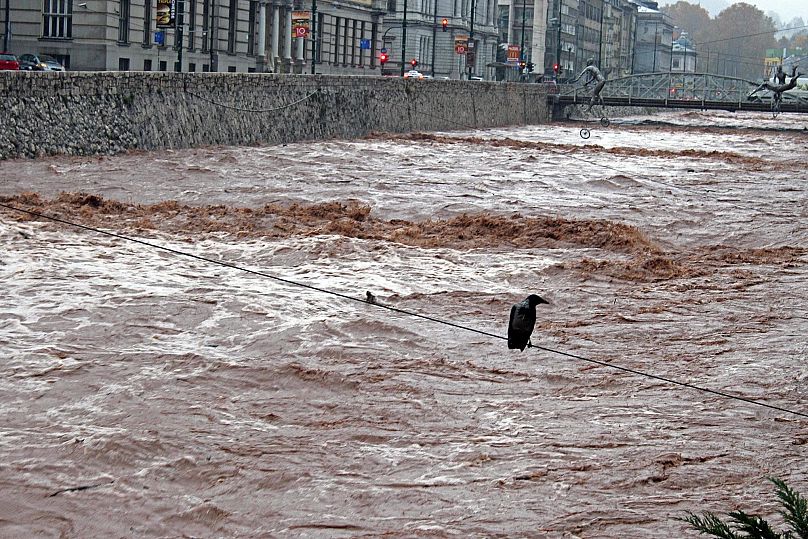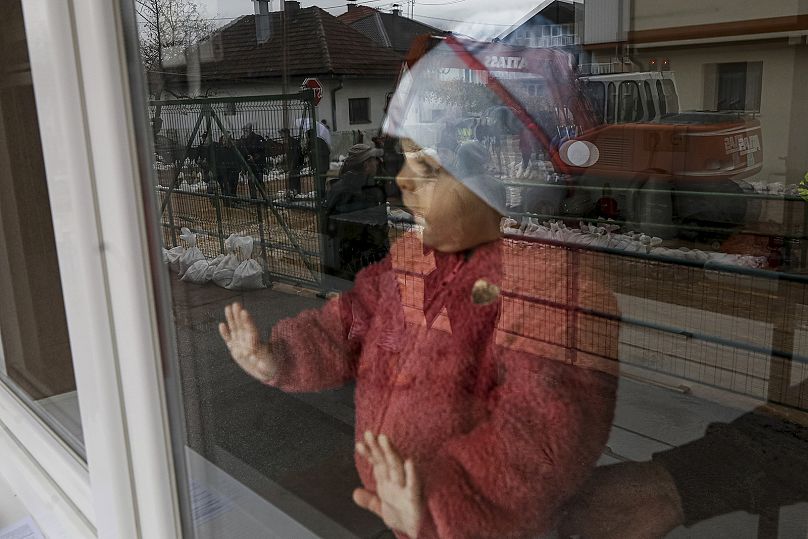Dozens of people had to be evacuated from their homes in the Sarajevo suburb of Otes and in the city of Konjic.
Flash flooding due to sudden heavy rainfall in parts of Bosnia and Herzegovina caused evacuations and significant property damage, sparking fears that there could be a repeat of the destruction that swept one-third of the country in 2014.
Dozens of people were evacuated from their homes on Friday in the Sarajevo suburbs of Otes and Rajlovac and in the city of Konjic, some 50 kilometers further south.
The rising water levels are a result of heavy rainfall that has been uninterrupted since late Thursday, causing problems in municipalities mostly within the proximity of the Bosna and Neretva rivers and their tributaries.
The flooding caused a number of electrical substations to malfunction, leaving a large part of the capital's outskirts without power.
Residents of the most affected neighborhoods, such as Otes, Vojkovići, and Rajlovac, have since remained off the grid.
Local outlets and social media users reported that the Miljacka river, which flows down the middle of the Bosnian capital, also reached unprecedented levels by Friday. At least one pedestrian bridge had to be closed for traffic.
Heavy rain also submerged a number of local and regional roads, cutting off traffic and threatening to destroy buildings along the riverbanks.
By Saturday, the rising levels of the Bosna river — which flows northwards from Sarajevo — blocked traffic and destroyed vehicles in the city of Zenica and the towns of Visoko, Kakanj, and Breza.
The floods have also caused significant damage to local businesses and agricultural farms. In the town of Trnovo, about 30 kilometres south of Sarajevo, one sheep farm owner lost his entire stock overnight, local TV station N1 reported.
With homes and roads imperiled in some municipalities, local schools also cancelled classes.
A residential care home for the elderly and a plant filling oxygen tanks for hospitals treating COVID-19 patients were also evacuated.
Forecasts say that the rainfall is expected to continue until Sunday, with projections of further rain to continue again on Monday.
Climate change meets government negligence
The water levels of some rivers have reached or surpassed those recorded in May 2014, when the country experienced destructive flooding, forcing the authorities to declare a weeks-long state of emergency.
The floods in 2014 caused 21 casualties, with two people still declared missing to this day. Thousands had to be evacuated, while the damage to property, infrastructure, and agricultural goods was estimated at around several billion euros.
One major consequence of the 2014 floods was the shift in the soil in areas with landmines remaining from the 1992-1995 war in the country, changing the previously mapped-out locations or bringing them closer to densely inhabited areas.
Vjekoslav Bevanda, state-level prime minister at the time, claimed that the damage to the country's economy amounted to about 15 per cent of Bosnia's GDP.
But little was done since 2014 to prepare for future flooding, especially since projections show that this might become a more common occurrence in the future due to climate change, says Mirza Novokmet, a natural disaster analyst.
"Heavy rain showers have been intensifying in the last couple of decades, and especially the last couple of years," he said.
"As we observed in the past few months in Germany, Italy and the Balkans, the amount of rain that usually falls averagely in a couple of months or more, now falls in a single event that could last anywhere between a few minutes up to a few hours or days."
"I think people still have the 2014 floods fresh in their memory, and to the people, it’s not unexpected," Novokmet stated.
"But the country didn’t do anything major to at least to mitigate some future flood events or the catastrophic consequences of these floods."
"They didn’t take it seriously. They kind of view it as something that will pass, that’s not going to be as catastrophic as the big floods in 2014," he explains.
While local authorities in Bosnia have borne the brunt of criticism for what is seen as an inadequate response by the citizens, Novokmet thinks that the responsibility lies with the country's top political leaders.
"Local communities have their own responsibility — for example, even a single household has their own responsibility to implement some measures."
"But these plans are usually made at the top level of government, or in the case of Bosnia, the cantonal or the entity level. I think that the coordination between all of the levels is missing. And the citizens are the worst off because they are the most vulnerable," he explained.
Bosnia has one of the most complicated systems of government in the world, a legacy of the 1995 peace deal struck to end the war in the country, designed to equally distribute power between its ethnic groups.
It saw Bosnia divided into two entities or subnational units, the Serb-dominated Republika Srpska and the Bosniak-Croat Federation of Bosnia and Herzegovina. The northeastern town of Brčko was declared a district, a separate and distinct administrative unit.
Each entity has its own assembly and government, overseen by a state-level parliament and council of ministers. The entity of the Federation of BiH is further divided into ten cantons, each with its own government.
Although handling natural disasters and other emergencies is supposed to be done mainly at the entity level, the 14 respective governments, each with varying degrees of responsibility, make up a dizzying maze of blame-shifting and slow decision-making, Novokmet believes.
"In Bosnia, you shift the responsibility from one instance to another in order to avoid taking any responsibility," he explains.
"If you point your finger at somebody, they can say, ‘Oh, it’s not our responsibility, you can talk to the cantonal level, to the entity level, the state level,' or even claim it's out of their hands because climate change is a global problem, and it’s down to the big countries like Russia, China, Western Europe, the US."
"I think that’s the main problem — if nobody can be blamed for it, nobody can bear the consequences," Novokmet concluded.













